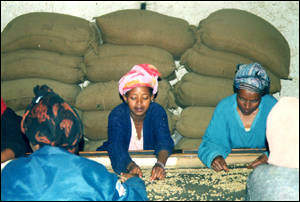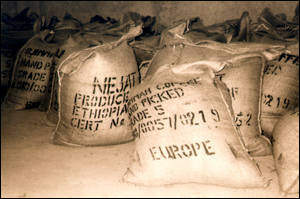 COFFEE PRODUCTION IN ETHIOPIA COFFEE PRODUCTION IN ETHIOPIA |
By: Yilma Yemane-Berhan Coffee expert
->Market liberalization
->Coffee Ceremony
 INTRODUCTION INTRODUCTION |
One thing is true. It is nature which initiated coffee production in Ethiopia thousands of years ago, in the jungles of Kaffa, Illubabor, Wollega, Bale and other regions.
Coffee grew as a second storey under the canopy of forest trees. It was in these forest that coffee arabica originated and then spread to the rest of the world to constitute the ancestor of the present day coffee plantations of the world.
In Ethiopia, coffee production by man started much later than the one by nature. It is believed that man started to grow coffee in the fourteenth or fifteenth century to supplement his natural coffee supply, and its production methods have passed through several stages: ranging from simply picking coffee berries from the forest to the management of modern coffee plantations. However, all these forms of production still exist today as will be briefly described later.
 COFFEE ECOLOGY COFFEE ECOLOGY |
Climate and soils are the two most important factors that determine the ecology of coffee. Rainfall and temperature are the main variables that influence coffee production and productivity. They are in turn affected partly by altitude.
The rainfall pattern in the coffee areas is generally monomodal, with an annual distribution from February to March to November. The next season, i.e. November to February, is dry spell. Although the average annual precipitation is 1300 to 1800mm, some areas receive 2000mm or more.
The ideal average temperature for Coffee arabica is considered to be 18-22CmC, and the temperature in the Ethiopian highland coffee areas falls within this range.
Most of Ethiopian coffees are produced in the highland areas, whose altitude range from 1500 to 1800 m above sea level. Some are also produced in areas up to 2000m.
It seems that one of the lessons man has learnt from nature, for sustaining his coffee environment, is the use of shade trees. Shade trees sustain production by preserving the coffee environment: maintenance and conservation of soil fertility and moisture; regulation of extreme temperatures; moderation of flower induction and fruiting to avoid overbearing and die-back; and improvement of coffee quality. The major shade trees in Ethiopia are leguminous plants which add fertility to the soil. They include acacia, albizia, milletia, sesbania, etc. Thus, Ethiopian coffee farmers have tried to maintain shade in one form or another. Some have only thinned the forest trees to plant coffee trees under them. Others have replaced them by more suitable ones. There are still others who have uprooted shade trees in areas where inter-planting is practised.
According to a recent experiment in Guatemala by renowned coffee agronomists, both shade and altitude improve coffee cup quality. Among other things, shade and altitude slow down bean maturation and thereby create favorable conditions for improvement in organoleptic quality. The study has also shown that the influence of shade on the organoleptic quality (cup quality) has a greater effect on the bitterness of coffee. Unshaded coffees are more bitter. Moreover, it has been ascertained that both shade and altitude increease the acidity and sugar concentration, which are in fact important factors in creating the aroma of coffees.
 MAJOR COFFEE GROWING ZONES MAJOR COFFEE GROWING ZONES |
In Ethiopia, coffee is grown almost everywhere. But so far, the major areas include Kaffa, Illubabor, Wollega, Gimbi, Sidamo, Gedeo, (including) Yirga-Cheffe, and Harrarge (consisting of 3 zones). A part from representing some of the distinctive coffee types, each area is also a place of their origin. For instance, coffee traded as 'Kaffa', is produced in Kaffa, in parts of Illubabor, Wollega and other regions.
 MODES OF COFFEE PRODUCTION MODES OF COFFEE PRODUCTION |
There are four main coffee production systems in Ethiopia: forest coffees, garden coffees, traditional small coffee farms and large scale modern plantations. It should, however, be noted here that the contribution of the forest coffees has been dwindling as a consequence of accelerated deforestation. On the other hand, small coffee farms contribute about 90% of the country's coffee, while state farms account for the rest. Under the government's new policy, the private sector can invest in the coffee industry. If this could be realized, it would mean the expansion of large scale commercial plantations with better technologies, and this would in turn enhance productivity and quality.

 HECTAREAGE VOLUME OF COFFEE PRODUCTION HECTAREAGE VOLUME OF COFFEE PRODUCTION |
Most of Ethiopian coffee grows in about 58 woredas (districts). Nonetheless, it is difficult to know the actual size of the total land under coffee cultivation, mainly due to the fragmented nature of coffee farms and the inter-cropping practices in the coffee farming system. Conservative estimations put the figure at 321,000 ha.
Although there is no accurate figure for the total annual coffee production in Ethiopia, the estimate is in the range of 200,000-250,000 tons with some fluctuations due to weather, prices, and the biennial nature of coffee plants.

| Unfortunately, about 35% of the total production is consumed within the producing areas. In addition, an unquantified volume of coffee is handled by illegal markets. It is known that a good part of the commodity finds its way to the neighboring countries illegally.
Contrary to the production figures, the data for the arrival of coffee from the interior to the terminal markets (Addis Ababa and Dire Dawa) for export are very accurate. The table below shows coffee arrivals to Addis Ababa for the last ten years. The 1996/97 (Coffee year is from 1st October to 30t September) coffee arrival and export (158,628 tons and 118,000 tons respectively) were the highest in the history of the Ethiopian coffee industry. Basically, arrival is correlated with production.
 THE POTENTIAL OF COFFEE PRODUCTION IN ETHIOPIA THE POTENTIAL OF COFFEE PRODUCTION IN ETHIOPIA |
As already mentioned, coffee is the major foreign exchange earner for Ethiopia. On the other hand, we note that domestic consumption is high and is likely to continue growing. Then the question is whether the country has the potential to satisfactorily meet the two needs. The answer is YES. The country has the potential as well as the capacity to produce enough high quality coffee. Some of the major factors that could increase the potentials of coffee production are the favorable ecology for highland quality production; the availability of very broad genetic base still largely untapped; the distinctive high quality coffees well appreciated in international markets, etc. The rich experiences so far gained in the overall coffee sector are also indispensable factors that can boost the potentials of coffee production. indeed, these factors constitute the foundation for the coffee development programmes in the country.
The Ethiopian coffee industry is also benefiting from international assistance, of which the European Union (EU) has had a major share, particularly in financing the Coffee Improvement Programme (CIP) since 1977. Currently, the programme is in its third phase and is expected to continue.
The main objectives of CIP include strengthening and supporting the coffee extension programme and research; providing farm inputs to farmer; and developing the manpower resources. It has also been learnt that there is a new plan for which EU will provide funds in order to establish pilot project centres for the protection and preservation of the forest coffee and its genetic diversity.
In order to fully exploit the existing potentials, all constraints related to production have been identified and prioritized in the latest studies carried out under CIP III, sponsored by the Coffee and Tea Authority (CTA) and EU. The main recommendations of the studies include:
a. further strengthening of the coffee extension service and making it participatory, in which extension staff, researchers and farmers would jointly work;
b. establishment of pilot project centres under the different ecological conditions for wide - scale adaptive trials, planting material production, training, and demonstrations; and
c. pomotion of a conservation based farming system for the sustainability of the ecosystem and coffee production, by adopting an agro- forestry type farming system in order to tackle some of the farmers' needs, such as conservation of moisture and soil fertility, arresting land degradation and improvement of coffee productivity and quality. the system will also enable the production of organic coffee; the integration of multipurpose trees/shrubs into the farming system; the provision of fodders for the livestock, wood for fuel and other purposes; and the provision of shades for coffee plantations.
 CONCLUSION CONCLUSION |
Undoubtedly, considerable efforts have been made to improve the Ethiopian coffee production. Nevertheless, there is still much more to be done in the future in order to maximize the country's coffee production and export capacity. The new slogan for the Ethiopian coffee industry should be AVAILABILITY, QUALITY AND SUSTAINABILITY. To this end, all available resources will have to be mobilized and deployed without any further delay.
->Market liberalization
->Coffee Ceremony
 COFFEE BACK GROUND COFFEE BACK GROUND |
Ethiopia, being the origin of coffee Arabica, its cultivation and trade has been performed since time in-memorial. Nowadays, it is estimated that nearly 400 thousand hectares of land is covered by coffee. The annual coffee production of the country ranges from 200-250 thousand tons. The coffee sub-sector fulfills a number of important functions for both the producers and the economy at large.
Coffee is the dominant foreign exchange earning export commodity of Ethiopia. Well over 60 percent of the country's foreign exchange is obtained through the export of coffee. It also contributes about 100 percent of government revenue. A quarter of the population is directly or indirectly engaged in the production, processing and marketing of coffee. Though not easily quantifiable, the multiplier effects of this commodity on other sectors of the national economy, such as wholesale and retail trades, banking and insurance, transport etc. are also enormous. In addition, coffee plays a significant role in the social and cultural life of the people.
The major share of coffee production in Ethiopia is accounted by small holder peasant farmers. Almost 95 percent of the total production is covered by these small holders and the remaining share of the output goes to the state owned enterprise i.e. Coffee Plantation Development Enterprise.
Ethiopian coffee is processed in two well known methods, the dry and wet methods. The bulk of the annual product nearly 80 percent used to be processed in sun-dried form while the rest is wet processed coffee. Due to the misguided economic policy of the Derg regime private investors were prohibited in the participation of either the processing or trade of washed coffee. Hence, the wet method of coffee preparation which fetches premium price in the world did not expand in the past but currently appreciable progress is being made. |

